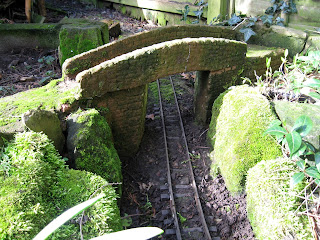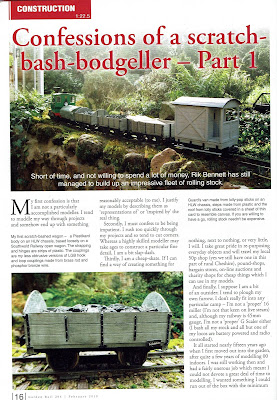 Introduction
Introduction
Winter time is usually when activity on the railway dies down. The weather is not conducive to operating trains outside and the hours of daylight are too short anyway to have a decent running session. It's normally a time when I do constructional projects indoors, but a spate of illness has slowed down my productive output this year. I have managed to turn round a few projects though, and carry out some maintenance.The most significant project has been the construction of a brewery building for the siding at Beeston Castle station. I have also managed, at long last, to replace the fencing behind the platform at Peckforton Station and repair the overbridge which was damaged during tree felling in the Autumn (see Progress Report 75). I have added an Acme Engineering soundcard to the HGLW diesel (see Progress Report 72) and begun the construction of rake of sand hopper wagons for the sand quarry which will be located on another new siding (see Progress Report 75). I have also continued replacing LGB couplings with my less obtrusive compatible wire couplings - a seemingly endless ongoing task! On the operational side, I have updated my freight management computer program with the newly added rolling stock (see Progress Report 74 and Progress Report 75) and a new location (ie the sand quarry siding). I have also found time to make a video showing how the railway has changed over the past twelve years - and also wrote a few articles for the Garden Rail magazine, two of which have already been published.
So, I don't think I have been idle over the winter period. The weather is beginning to improve and I have now cleared the track, so it might be possible that trains will start running again in the not too distant future.
Lineside
Over the past year, I have been focusing more on adding lineside detail, particularly industries to the railway. I've added a sawmill at Peckforton (see How I constructed the sawmill), together with a boiler house and water tower (see How I constructed the boiler house and How I constructed the water tower). I have also constructed a water mill (see How I constructed the water mill and sluice gate (see How I constructed a sluice gate) for the mill siding between Peckforton and Bulkeley. In addition, I have made a loading bank for the soft fruit harvest at Bulkeley (see How I constructed a loading bank). These were made from a variety of materials, concrete (loading bank), wood (sawmill) and PVC foamboard (mill, boiler house and water tower). I have become very enthusiastic about using foamboard as it is a versatile material and also relatively cheap. This was why it was chosen for the construction of the brewery at Beeston Castle.Beeston Brewery
After searching the web for suitable prototypes, I eventually decided to base my model on the now discontinued Metcalfe 00 card model as this presented me with a fairly generic building. After measuring the intended site and making a few sketches, I initially mocked-up the building in corrugated card, ........before cutting into my stocks of 5mm thick PVC foamboard.
As can be seen, it is a snug fit in this tight corner of the railway. There are still a few minor details which need to be sorted out, not least a concrete base on which to mount it and re-positioning the siding slightly, but overall I am pleased with the outcome. For more information see How I constructed the brewery (pending)
Peckforton platform fencing
While changing the track layout at Peckforton to provide more room for the sawmill (see Progress Report 72), I also took the opportunity to raise the track in the middle of the station where there was a small dip. This meant I had to rebuild the platform (see Progress Report 73) and as a consequence the fencing behind the old platform was removed. Now, after a year, I finally got around to replacing the fencing.I also took the opportunity to create a second running in board which I felt would be appropriate for a station with a single platform.
All the original fencing was re-used, though some is beginning to show its age with broken palings. However, I decided that, as my railway is set in the 1930s, at the time of the Depression, then things might have started to deteriorate.
Overbridge repairs
The parapets of the two cast concrete overbridges had survived unscathed for eight or nine years until last Autumn when I managed to knock one off while lopping and felling trees (see Progress Report 75). I have now got around to repairing it, using a two-part epoxy masonry repair kit.Before ........
..... ad after.
One crack is still visible but, in time, I'm sure this will fade.
Stock
Since the spate of Anglicising a couple of closed vans and open wagons (see Progress Report 75), activity related to rolling stock has been fairly quiet. I have, however found time for a couple of projects:HGLW diesel sound card
After completing the Houston Gate Loco Works (HGLW) kit last year, I decided it was time she gained a voice. I've never used Acme Engineering soundcards and so decided to give one a try (see How I added an Acme Engineering sound card to my HGLW diesel loco). I was attracted by the card's small footprint and because it has digitised real sound effects.
Rather than using the 9v battery which came with the card, I opted to increase the battery power in the loco from one 3.7v li-ion battery to two, giving me a nominal 7.4v. Other than that, the installation was very straightforward and the sound quite effective.
Sand hopper wagon
I had been wondering what industry might occupy the longer siding on the approach to Bickerton station when I happened to pick up a copy of Eric Tonks' book about the Snailbeach District Railways (Industrial Railway Society, 1974, reprinted 2007). I have always been attracted by the wooden hopper wagons which ran on this railway and when I noticed there was a drawing of one at the back of the book, I felt it was an omen. Having a few Hartland Locomotive Works (HLW) mini-series chassis sitting in a spares box, I decided to experiment to see if I could produce a passable replica of a wagon to use as a prototype.Having proved it is possible, I will now produce another seven or eight with improvements and modifications in the process. Once the fleet is completed, I will write up the definitive guide to their production (see How I constructed a rake of Snailbeach style hopper wagons - pending).
Couplings
This is an ongoing process, but I am at last beginning to see light at the end of the tunnel. The design appears to be effective and so around 80% of the stock has now been equipped. I am leaving the locos until last as I anticipate they are likely to be the items which will require the most personalised couplings.I noticed in one of my videos that the new couplings are a lot less obtrusive than the LGB originals, which is encouraging - see 1m 50sec into this video:
Operation
As indicated above, this time of year is not conducive to running trains in the garden, but I have made a few changes which will affect train operations once they resume.Freight management program updates
Because I have added some more rolling stock to the freight roster for the railway (see Progress Report 74 and Progress Report 75), I have now added these to the wagon database in my freight management computer program (see How I handle freight on my railway). In addition, I have added a new location - the sand quarry, as indicated above. As a consequence, the parameters controlling the movement of each wagon on the railway has had to be revised to take account of this new location. However, this is not as daunting as it sounds, because very few wagons will be likely to serve the sand quarry - a tanker wagon, to transport fuel oil, a flat wagon to occasionally transport pieces of machinery and an occasional closed van for miscellaneous goods. |
| The new siding to the sand quarry before final ballasting |
Retrospective video
While sorting through some folders on one of my backup disks, I came across some video clips which I had not previously used. These dated back to the early days of my railway and so I decided to make a video comparing these early clips with ones taken more recently. The result is a retrospective video which is not only nostalgic for me, but also shows how much progress the railway has made over the past eight to ten years.General
There are always plenty of jobs to be done on or associated with a garden railway. In recent weeks, I have spent some time out in the garden, clearing some of the accumulated leaves and debris which have found their way on to the track, and also cut back some of the plants which are already threatening to impede traffic when the railway resumes operations. As indicated above, a few repairs have also taken place. In addition, I have added a bit more storage in my workshop and also found time to pen a few articles about the rolling stock on my railway.More storage in workshop
I never seem to have enough storage space. No sooner do I add more and it gets filled and I am looking for some more. I felt I needed a few more shelves to store stock, such as those awaiting repair or new couplings. I speculated for a while how I would support shelves on the window side of the conservatory and eventually opted for a simple belt-and-braces approach with triangular wooden brackets cut from a length of timber shelving. Elegant, they are not, but functional they are. It's a good job I have a partner who is very tolerant of my railway and the way it encroaches on other parts of the house.The shelves are now finished and already full of items of rolling stock and other miscellaneous odds and ends. How on earth did I manage without them?
Magazine articles
So far, two of the articles I have written about my rolling stock have appeared in Garden Rail, the February 2019 edition:.... and the March 2019 edition.
Although some of the information they contain has been covered in various posts on my blog, the articles are completely new and take a quite different stance. I hope any regular followers of my blog will find them equally as interesting and informative.












